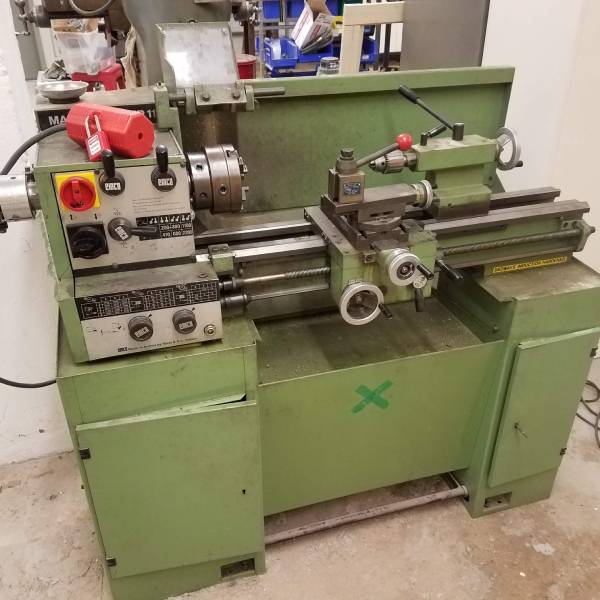Understanding Lathes: What They Are & How They Work
Introduction to the Lathe Machine
A lathe is a powerful tool essential in shaping materials. It uses a fixed cutting tool and rotates the workpiece to remove unwanted parts. This process creates objects with precise symmetry and smooth finishes.
Definition and Core Functionality
A lathe is a tool that shapes wood, metal, or plastic. It holds the workpiece on an axis and spins it while a cutting tool trims it to size. Lathes are key in making parts like screws or musical instruments.
From simple wood bowls to complex machine parts, lathes handle a variety of materials with ease. With their ability to perform multiple tasks, they are a fixture in many workshops. Their main function is to cut, but they can also drill, groove, and polish, making them versatile workhorses. A lathe is used for various tasks, including cutting, drilling, grooving, and polishing, making it an essential tool in workshops for handling diverse materials, from simple wood bowls to intricate machine parts.
![]()
Key Components of a Lathe
A lathe masters precision shaping with key parts that work in harmony. Understanding these components reveals how lathes sculpt with such accuracy.
Headstock
The headstock anchors the lathe, it houses the main spindle, crucial gears, and often the motor. This end sets the pace for the workpiece’s spin.
Tailstock
Opposite the headstock, the tailstock offers support. It secures the other workpiece end, ensuring stability and precision during the lathe operation.
Carriage and Bed
Connecting the headstock and tailstock, the carriage glides over the bed. It holds, moves the cutting tools, and ensures a smooth path for precise cuts.
Spindle and Chuck Systems
At the lathe’s heart, the spindle spins the workpiece. The chuck system grips it tightly, ensuring a secure hold as it turns.
Cutting Tools and Attachments
Cutting tools, from sharp bits for shaping to drills for making holes, are the lathe’s scalpel. Attachments expand the lathe’s capabilities, allowing for a wide range of craftable shapes and designs.
Operations Performed on a Lathe
The lathe is a versatile beast, adept at a myriad of operations. Let’s walk through some common tasks performed with this pivotal machine.
Turning and Facing
Turning shapes the outer part of your workpiece, slicing away material to a specific diameter. Facing cleans up the end of your workpiece, giving it a flat surface that’s squared off nicely.
Drilling and Boring
Drilling punches straight-through holes in your workpiece. Boring takes those holes and widens them or fine-tunes their dimensions.
Threading and Tapping
Threading makes spiral grooves, like on a bolt, while tapping forms matching internal threads, preparing a hole to accept a threaded bolt.
![]()
Knurling and Grooving
Knurling creates a textured pattern, perfect for a non-slip grip. Grooving carves out narrow recesses, often to house things like O-rings.
Parting and Reaming
Parting severs your workpiece, cutting it off from the stock material. Reaming smooths out and perfects the dimensions of drilled holes.
Types of Lathes
Lathes are classified by their functionality, precision, and the type of control they utilize. Different types cater to varied manufacturing needs, showcasing their unique capabilities. Here’s a look at some common lathe types. Among the various types of lathes, the jet metal lathe stands out for its versatility and precision, making it an excellent choice for both professional and hobbyist machining tasks.
Engine Lathes
Engine lathes are versatile and widely used. They handle various materials with manual control. Engine lathes suit tasks ranging from simple to complex, serving as a staple in many workshops.
CNC Lathes
CNC (Computer Numerical Control) lathes bring precision and repeatability. They use digital instructions for automated operations, making them ideal for intricate and consistent production runs.
Turret Lathes
Turret lathes are known for their efficiency in mass production. They feature a mounted turret, enabling quick tool changes without manual adjustments, perfect for high-volume tasks.
Toolroom Lathes
For jobs needing high accuracy, toolroom lathes shine. They offer more settings for precision, suited for making tools, dies, and complex prototypes.
Specialized Lathes
Specialized lathes cater to unique tasks. They include vertical lathes for handling hefty workpieces and Swiss-type lathes for precise small parts machining in high-tech industries.
Applications of Lathes in Manufacturing
Lathes have a vast range of applications in manufacturing. They shape, cut, and finish a variety of materials for use in many industries. Here’s how lathes are employed in various sectors.
Metalworking and Woodworking
In metalworking, lathes craft parts like gears, bolts, and brackets. Woodworkers use lathes for turning spindles, bowls, and furniture legs. Both fields rely on lathes for precision and smooth finishes.
![]()
Glassworking and Pottery
Glassworkers use lathes to shape delicate glass objects. Potters shape clay into vases and plates on a lathe, known as the potter’s wheel.
Tool and Die Making
Makers of tools and dies turn to lathes. They shape the metal into precise molds and cutting instruments.
Aerospace and Automotive Components
Lathes are vital in aerospace and auto manufacturing. They produce engine parts, landing gear components, and car shafts with strict accuracy.
Advantages of Using a Lathe
When it comes to machining, lathes bring a lot to the table. They adeptly handle multiple tasks, shape materials with finesse, and drive production efficiently. Here’s a closer look at why lathes are such a powerhouse in the manufacturing industry. Understanding how to use a lathe effectively is crucial for maximizing its potential in machining, as this versatile tool not only streamlines production but also enhances the precision and quality of shaped materials in the manufacturing process.
Versatility in Machining
Lathes are the Swiss army knives of machine tools. They can turn, drill, thread, and more—all on a single machine. This makes them ideal for shops dealing with diverse projects. Lathes adapt to different shapes and sizes, managing a variety of machining tasks with ease.
High Precision and Accuracy
Precision is key in manufacturing, and lathes deliver on this front. They’re designed to achieve extremely tight tolerances, making them indispensable for detailed work. Whether crafting intricate parts for watches or aerospace components, lathes maintain strict dimensions and produce consistent results every single time.
Efficiency in Production
Lathes excel not just in versatility and precision, but also in efficiency. They often require less setup time than other machines for similar tasks. Some, like CNC lathes, run on pre-programmed instructions, minimizing the need for operator intervention and speeding up production. They enable quick turnarounds, especially valuable in high-volume environments.
Safety Considerations for Lathe Operation
Operating a lathe requires meticulous attention to safety due to high-speed rotating parts and sharp cutting tools. Ensuring safe use and preventing accidents is paramount for anyone operating or working near a lathe. Here are key safety measures to keep in mind.
Importance of Sharp Tools
Keeping lathe tools sharp is not just about maintaining efficiency and precision. Dull tools can snag or force the operator to apply more pressure, potentially leading to slips or breaks. Regularly check and sharpen your tools to ensure safe and optimal performance.
Use of Lathe Shields and Guards
Lathe shields and guards serve as critical barriers between the operator and flying debris or broken tools. They help to protect against accidents and injuries. Always inspect these safety features before use to ensure they are in proper working order and positioned correctly.
Personal Protective Equipment (PPE)
Proper PPE is vital when using a lathe. Safety goggles protect your eyes from metal shards and wood splinters, while gloves guard against cuts. Long hair should be tied back, and loose clothing secured to prevent entanglement with the machine’s moving parts.
Operator Training and Expertise
Skilled operation of a lathe is crucial for safety. Inexperienced operators should receive thorough training to understand the functions and risks. Veterans and novices alike must stay updated on the latest safety practices and always approach the lathe with focus and caution.
Final Thoughts
The lathe’s influence in today’s manufacturing can’t be overstated. It’s a cornerstone of innovation and creation, transforming raw materials into precision components. Whether for crafting intricate jewelry or robust aerospace parts, the lathe’s role is fundamental.
The Significance of Lathes in Modern Manufacturing
Lathes mold our world, shaping the pieces that build our machines, vehicles, and technologies. Their ability to sculpt with such precision makes them indispensable in any advanced production. They symbolize the blend of art and science, turning engineering visions into tangible realities.



